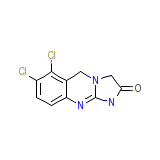Anagrelide, Hydrochloride




Anagrelide, Hydrochloride Brand names, Anagrelide, Hydrochloride Analogs
Anagrelide, Hydrochloride Brand Names Mixture
- No information avaliable
Anagrelide, Hydrochloride Chemical_Formula
C10H7Cl2N3O
Anagrelide, Hydrochloride RX_link
http://www.rxlist.com/cgi/generic/anagrel.htm
Anagrelide, Hydrochloride fda sheet
Anagrelide, Hydrochloride msds (material safety sheet)
Anagrelide, Hydrochloride Synthesis Reference
No information avaliable
Anagrelide, Hydrochloride Molecular Weight
256.088 g/mol
Anagrelide, Hydrochloride Melting Point
280 oC
Anagrelide, Hydrochloride H2O Solubility
Very slightly soluble
Anagrelide, Hydrochloride State
Solid
Anagrelide, Hydrochloride LogP
2.333
Anagrelide, Hydrochloride Dosage Forms
Capsules (0.5 mg or 1 mg)
Anagrelide, Hydrochloride Indication
For the treatment of patients with thrombocythemia, secondary to myeloproliferative disorders, to reduce the elevated platelet count and the risk of thrombosis and to ameliorate associated symptoms including thrombo-hemorrhagic events.
Anagrelide, Hydrochloride Pharmacology
Anagrelide is a drug used for the treatment of essential thrombocytosis (ET; essential thrombocythemia). It works by inhibiting the maturation of megakaryocytes into platelets. The exact mechanism of action is unclear, although it is known to be a potent (IC50 = 36nM) inhibitor of phosphodiesterase-III.
Anagrelide, Hydrochloride Absorption
No information avaliable
Anagrelide, Hydrochloride side effects and Toxicity
There are no reports of overdosage with anagrelide, however thrombocytopenia, which can potentially cause bleeding, is expected from overdosage. Single oral doses of anagrelide at 2,500, 1,500 and 200 mg/kg in mice, rats and monkeys, respectively, were not lethal. Symptoms of acute toxicity were: decreased motor activity in mice and rats and softened stools and decreased appetite in monkeys.
Anagrelide, Hydrochloride Patient Information
Anagrelide, Hydrochloride Organisms Affected
Humans and other mammals














